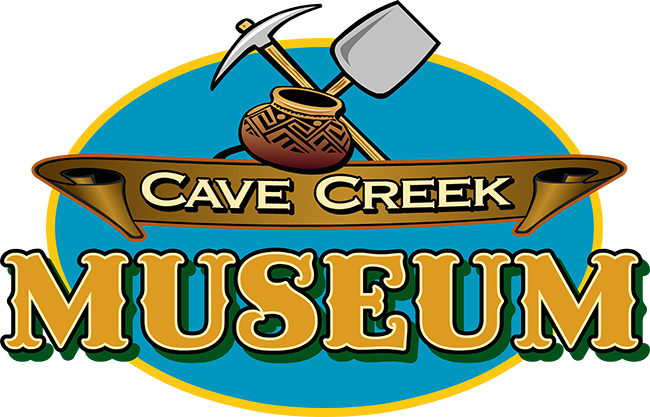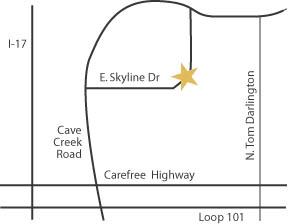
DESIGNATE & DONATE
You can support our mission without reducing your income or diminishing your savings.
Think about using assets that can be transferred to Cave Creek Museum without legal expense. You may have bank investments, retirement, insurance, stock, or mutual-fund accounts that you can use to accomplish your charitable goals. All these assets can be transferred by completing a P.O.D. (Payable on Death) or T.O.D. (Transfer on Death) form. Some companies also call these beneficiary designation forms. This completed form tells the account custodian what to do with the account after your passing.
You can name the Museum in your long-term plans today without a negative impact on cash flow or lifestyle. Keep it simple and savvy. Ask your bank for a P.O.D. form. Ask your retirement plan, investment account or insurance company for a T.O.D. form. Designate and donate with any of these assets. It takes less than five minutes of your time.
Ask the plan custodian for a T.O.D. form. Some companies also call these forms beneficiary designation forms.
How It Works
- Contact the plan custodian or account holder about a T.O.D. (Transfer on Death) or beneficiary designation form.
- Designate the Museum (Tax ID #94-2404270) to receive all or a portion of the assets held in the retirement plan.
Benefits
- Avoid the potential double taxation your retirement savings would face if you designated these savings to your heirs.
- Continue to take regular lifetime withdrawals.
- Maintain flexibility to change designation if your family’s needs change during your lifetime.
Retirement Accounts: A Wise Charitable Gift
Planning for retirement is critical to your financial well-being. If you are reading this section, chances are you planned well, but you also know that life is unpredictable. The good news is that you can make a significant gift to the Museum with retirement plan assets without adverse effects to your lifetime finances. In fact, leaving retirement plan assets to us can be one of the best financial decisions you can make. Here’s why.
Traditional retirement plans such as Individual Retirement Accounts, 401(k) and 403(b) plans are funded with pre-tax dollars. The contributions and earnings that you make to this account are not subject to income tax. When you reach the age of 59½, you can take money out of your retirement account without penalty, but you do have to pay ordinary income tax on the distributions. If funds remain in the account after you pass away, be aware that your heirs may have to pay inheritance and estate taxes in addition to income taxes. Depending on the size of your estate, these combined taxes can be as much as 60% of the remaining account balance. Don’t make this mistake! Leave your retirement plan assets to the Museum. Whatever portion of the assets is left to charity will be exempt from income, inheritance, and estate taxes.
When planning to support the Museum and leave assets to loved ones, make certain that you leave your pre-tax assets to qualified charities and your other assets to your loved ones. This strategy assures that your heirs pay less tax on the assets that they receive.
Contact your account custodian today and complete the beneficiary designation forms to maximize the tax savings, take care of your loved ones, and leave a legacy at the Museum.
————————————————————–
The “Tax-Free” Gift: Qualified Charitable Distributions
(Also referred to as Charitable IRA Rollover Gifts)
Did you know the gift of a Qualified Charitable Distribution (QCD) benefits donors aged 70 ½ and up?
The Qualified Charitable Distribution is an excellent way to show your support for the Cave Creek Museum and receive tax benefits in return. Whether you are planning your required minimum distribution (RMD) or not, consider making a gift from your traditional IRA to make the most of your charitable giving. You receive a tax benefit even if you take the standard deduction!
It’s important to consider your tax situation before deciding whether to make a charitable contribution from your IRA. Be sure to share this gift plan with your financial advisor.
To Qualify
- You must be 70 ½ or older at the time of the gift.
- Distributions must be made directly from a traditional IRA account by your IRA administrator.
- Gifts must be outright, meaning they go directly to the Cave Creek Museum. Distributions to donor-advised funds or life-income arrangements such as charitable remainder trusts and charitable gift annuities do not qualify.
- Gifts from 401(k), 403(b), SEP and other plans do not qualify. Ask your financial advisor if it would make sense for you to create a traditional IRA account so you can benefit from an IRA Qualified Charitable Distribution.
Tax Benefits
- IRA Qualified Charitable Distributions are excluded from gross income for federal income tax purposes on your IRS Form 1040.
- The gift counts toward your required minimum distribution for the year in which you made the gift.
- You could avoid a higher tax bracket that might otherwise result from adding an RMD to your income.
Ask the brokerage or mutual fund custodian for a T.O.D. form. Some companies also call these beneficiary designation forms.
How It Works
- Contact your broker or investment account holder about a T.O.D. (Transfer on Death) or beneficiary designation form for mutual funds or other types of investment accounts. Our tax ID is:
Benefits
- You receive an income tax deduction for the fair market value of the securities on the date of transfer, no matter what you originally paid for them.
- You pay no capital gains tax on the transfer when the stock or share of investment account is sold.
Stocks and Investment Accounts: You’ve Planned for the Future
Investment accounts hold cash or stocks for the long term. You may have a mutual fund or a brokerage account, which is held at a financial institution. The objective of these accounts is to achieve long-term growth, provide future income, or preserve capital. After your passing, the remaining account balance may be transferred to heirs or charity.
When you opened the account, you should have received a form that tells the financial institution what to do with the assets when you pass away. This form is called a “Transfer on Death” (T.O.D.) form. With it, you decide how your assets will be transferred. If you do not complete this form, you will cause unnecessary confusion among your heirs and added expense to your estate administration.
Keep it simple. Ask the account custodian for a T.O.D. form, complete it, and share it with your financial or legal advisor. You can also leave all or a percentage of the assets, too. Any portion of your investment account left to us will be exempt from estate and inheritance tax. You also avoid paying any capital gains on assets that have increased in value over the years!
Ask the insurance company for a T.O.D. form. Some insurance companies also call these beneficiary designation forms.
How It Works
- Contact your insurance company to complete or update your beneficiary designations or P.O.D. (Pay on Death) form.
- Designate the Museum (Tax ID #94-2404270) to receive all or a percentage of your life insurance policy proceeds.
- You may also transfer ownership of a paid-up life insurance policy to the Museum. We may elect to cash in the policy now or hold it.
Benefits
- Make a gift using an asset that you and your family no longer need.
- Receive an income tax deduction for the donation of a paid-up life insurance policy and estate tax savings after your passing.
Life Insurance: Make the Most of It
Life Insurance is a general term that describes many types of contracts between an insurer and an individual. All life insurance policies share three key elements: an owner, an insured, and a beneficiary.
- The Owner — The person who purchases and controls the policy,
- The Insured — The person who is covered by the life insurance policy. That person may also own the policy, and
- The Beneficiary — The person who will receive the value of the policy upon the passing of the insured. An individual, estate, trust, or charity may be the beneficiary.
Most people decide to buy life insurance when they have people who are dependent upon them — children, partners, or family members. They want to provide for their loved ones after they pass away and do this by designating beneficiaries. Life Insurance can also be an important estate-planning tool and used to mitigate inheritance and estate taxes. The varieties and variations of life insurance products are endless and it’s essential that you consult a trusted financial or legal advisor to understand exactly what you are buying when you purchase life insurance. Know whom you have designated as your beneficiaries and review beneficiary designations regularly.
To make the most of your life insurance contract, consider if you still really need it.
- Are your children doing well in life?
- Do you have other assets that will provide for partners and loved ones?
- Have you been more financially successful than you anticipated?
- Have your financial priorities changed, and as a result, you now wish to do more for the Museum?
If you answered “Yes” to any of these questions, it’s time to review your beneficiary designation forms.
Any portion of your life insurance policy assets that you leave to the Museum will be exempt from inheritance and estate taxes. You can leave all or a portion of your policy.
Individual & Jointly-Held
Ask the bank for a P.O.D. form. You can still Designate and Donate, even when you have a loved one as a joint account owner. After your passing, what remains in the checking and/or savings account will be transferred to Cave Creek Museum.
How It Works
- Contact your bank to complete or update your P.O.D. (Payable on Death) form for your checking, savings accounts, and jointly held accounts.
- Designate the Museum (Tax ID #94-2404270) to receive the remaining account balance after your passing.
Benefits
- You maintain control and use of the account balance during your lifetime.
- Receive a charitable deduction, which will reduce any estate or inheritance taxes.
- The Museum receives the balance of the accounts to use according to your wishes.
Checking and Savings Accounts: A Gift You Can Make
When you opened your checking and savings account, you signed paperwork describing how the bank account will work. Do you remember what will happen to the bank accounts after you pass away? P.O.D. is short for “Payable on Death.” The P.O.D. form tells the bank who will receive the funds remaining in the bank account when the account owner passes away. Your loved ones and/or the Museum may be listed on the P.O.D. form. This is a meaningful way to begin your charitable legacy. It also keeps your bank accounts from becoming part of your estate, which may have to be administered by the probate system in your state.
Jointly Held Accounts
You may be a joint owner of the account, or you may have made a loved one a joint owner. The joint-owner may make deposits and withdrawals during your lifetime. The joint owner may also have “rights of survivorship,” meaning that he/she will automatically inherit the account when you pass away. Even if you have a joint account, you should complete the P.O.D. form to assure that the bank knows what to do with the remaining assets when both account holders have passed away. This step will also assure that the account may not become part of a time consuming and costly probate process.
Gift savings bonds to your favorite charity through your estate plan and save your heirs from excess taxation.
You can donate savings bonds to Cave Creek Museum by designating us (Tax ID #94-2404270) as a beneficiary of the bonds. By including a provision in your will, we can become the owner after your passing. By doing so, your estate will not owe income taxes when we cash them in. It’s another great way to save on taxes and support our mission.
There are many types of savings bonds so be sure to speak with your financial advisor.
Easy assets you can donate that will not affect cash flow, with little or no legal expense.
How It Works
- You transfer a work of art or other personal property to Cave Creek Museum.
- The Museum may hold and display the work or use it in the furtherance of its mission.
- The Museum may sell the property at some point in the future and use the proceeds towards its mission.
Benefits
- You receive an immediate income tax deduction for the appraised value of your gift and pay no capital gains tax, so long as the gift can be used by the Museum to carry out its mission.
- Without using cash, you can make a gift that is immediately beneficial to the Museum.
Is this gift right for you?
A gift of personal property is for you if …
- You hold artwork or other personal property that you no longer wish to maintain.
- You hold equipment or other items that would be useful to our mission.
- You want to avoid capital gains tax on the transfer of these assets.
The IRS gives donors who contribute appreciated property, like securities and real estate, two tax breaks: a charitable deduction for the full fair market value of the asset, and no capital gains tax on the transfer to the Museum.
The same benefits also encourage gifts of personal property: artwork, antiques, equipment, and other items that help us advance our mission.
If you are considering such a gift, please talk with us first. We can determine if the items can be used by us – a requirement for you to claim a full deduction. If you donate personal property that is liquidated for cash, the IRS will limit your charitable deduction to your cost basis in the property.
We do reserve the right to sell the property later if it can no longer be used or properly cared for by the Museum.
Planning points
- You will need to secure an independent appraisal of the property to establish the amount of your deduction.
- Most gifts of personal property are made to the Museum outright. In some cases, it may be possible for you to arrange another type of a giving option such as a life income gift. Consult with your advisors and our office before proceeding with such a plan.
The gift planning information presented on this site is intended as general. It is not to be considered tax, legal, or financial advice. Please consult your own personal advisors prior to any decision. Read full disclaimer.

